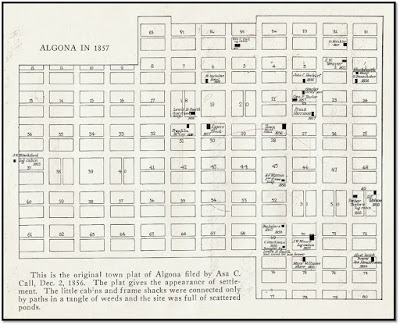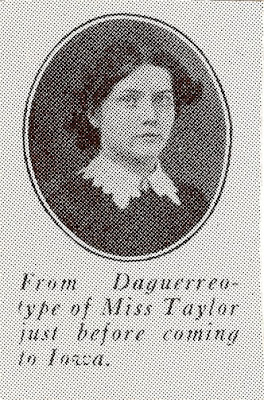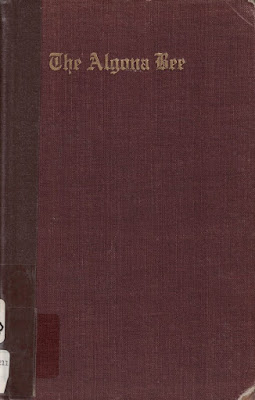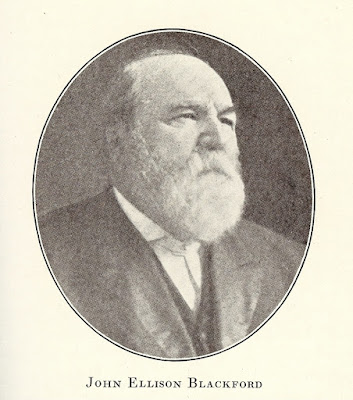I
was recently asked to do a presentation at the annual meeting of the Kossuth
County Historical Society about the “The Bee” -- the first “newspaper” in
Kossuth County. I thought that many of
you might also enjoy knowing a little about this handwritten paper that first
brought the local news to members of the Monday Reading Club.
ALGONA IN 1857
Before
we take a closer look at The Bee, it would be a good idea to see what Algona
was like in 1857. Lewis H. Smith had
surveyed the town and a plat had been filed by Asa C. Call on December 2,
1856. While the plat looks very official
and gives the impression of settlement, you can see that the photo states, “The
little cabins and framed shacks were connected only by paths in a tangle of
weeds and the site was full of scattered ponds.”
At
the time there were 16 residences (including the Blackford home which was
technically outside city limits and Bachelors Hall which served as housing to
various individuals for several years).
Also located on the town site was the Town Hall, St. Nicholas Hotel, the
Benschoter blacksmith shop, Major Williams’ store, Lewis Smith’s office, and
the Eggers Block. Although I could not
find a head count, I would guess that there were approximately 75-100 people
that lived in Algona by December of 1857.
At
the time, all news was received either by citizens returning after trips to
replenish supplies or by stage coach mail delivery. The stage road between Algona and Fort Dodge
was well marked, with a stop in Irvington.
How regularly those stages ran in 1857 is not documented. But no local news was reported in any formal
way.
The
majority of settlers in Algona were adventurers, giving up comfortable lives in
civilization to venture out into the unknown frontier. Now that they had chosen a permanent
settlement to build into their own city, they yearned for more than just the
physical comforts they had left behind. Among
the citizens were several college educated members such as Asa Call, Havens
Watson, and Dr. Franklin McCoy, all of whom would go on to edit issues of The
Bee. Many of the others had received a good education and all citizens yearned
for social and cultural activities to enrich their lives of hard work and
depravation.
SOCIAL AND EDUCATIONAL CLUBS ESTABLISHED
To
nourish that hunger, several clubs were soon founded in the little
settlement. The Monday Reading Club was
formed along with the Literary Circle and the Council Fire. One of the other highlights was Father
Chauncey Taylor’s Singing School. Father
Taylor was a big influence on the community being the driving force behind the
building of the Town Hall which was also used as a school and a meeting house
for church services. It was likely he
that persuaded his daughter, Harriette, to edit the first edition of “The
Bee.” And so on December 27, 1857, she
stood on the board floor of the J. W. Moore log cabin and read the paper which
consisted of seven handwritten pages and one page of magazine clippings. The cabin was only 16 x 20 feet in size so it
is likely that it was crowded, with people seated wherever they could find a
place, which probably included chairs, beds, fireplace hearth, and possibly the
floor.
I
don’t know about you, but I have a tendency to get “drawn in” to stories,
imagining what it would have been like to be present at these gatherings. Who was there? What kind of refreshments were served? What were the weather conditions I would have
had to travel through to get there? Some
of those who could have been in attendance were members of the Rist family
including Mr. and Mrs. Luther Rist, their son, Francis, and his wife, Eugenia
Kennedy Rist; Mary and Havens Watson; Lewis H. Smith; Asa and Sarah Call; and
the Call brothers’ sister, Mary Blackford and her husband, John. Others in the community who perhaps attended
the event were James and Electa Henderson; Charles Gray and his wife; Oliver
Benschoter; and Elias Weaver.
THE READING OF THE FIRST ISSUE
Can
you picture it? A young woman of 23,
standing somewhat nervously and yet proudly in front of the members of the
Reading Club and perhaps a few others in that log cabin on a cold winter’s
night, sharing the stories she had either written, clipped from magazines or
collected from contributors, including her father.
She
began with the following:
“We are happy to
present to our friends this first number of “The Bee” as the first paper
published in this “little world of Algona” and tho now small and may be
insignificant in the eyes of many, still we have sanguine hope that it will
thrive and before many years stand the first and oldest among our village
papers. A person when first starting in an enterprise like this feels
rather delicately. Many fears arise wether the paper will suit the
readers. Knowing there are as many minds as persons and also knowing that
unless all these minds are satisfied we are the losers, we feel still more
anxiety than we would otherwise.
“The Bee is intended
to be strictly a neutral paper. We shall strive to please all by
offending none. It will abound in wit and humor—be graced with sound
intellectual studies and pleasing stories—have all the news of the day—we hope
none of the gossip. We have able correspondents for The Bee who will
favour it with their productions from time to time. A few advertisements
will be inserted just to help pay expenses. We have tried to tell
you—imperfectly however—what we shall strive to make The Bee, and we humbly beg
our friends to stand by us and not allow it to sink into obscurity as the paper
in our neighbouring county has done.”
THE LOST IS FOUND
According
to the book “The Algona Bee” written by Harvey Ingham in 1922, no one knows how
many issues were published of The Bee.
We do know however that 23 survived.
When they came into his possession, Mr. Ingham had them bound in a book
which he delivered to the State Historical Society of Iowa in Des Moines for
preservation and safekeeping.
The
Kossuth County Genealogical Society began a project five years ago to digitize
all historical county newspapers. As a
part of that project we had hoped to digitize and offer online the surviving
issues of “The Bee.” However, when we
contacted the State Historical Society to make arrangements, the book could not
be found. I discussed this with a
representative of the Advantage Companies which is the company that has the
contract to do the microfilming and digitizing for the Society. She recommended that I contact Delpha
Musgrave, a long time staff person at the State Historical Society. I was told that if anyone could find it, it
would be Delpha.
I
wrote to Delpha, giving her as much information as I could about the book to
aide her search. I believed that Harvey
Ingham wrote his book “The Algona Bee” after 1920 and from references in “Early
Algona” written by Florence Call Cowles and published in 1929, I knew that she had
used The Bee book while writing her book.
To my extreme delight, Delpha soon contacted me to let me know that the
lost had been found. Rather than being
returned to the area designated in State Historical Society records, the book
had been filed with the personal papers of Harvey Ingham.
The
Historical Society did allow the book to be released to Advantage Companies for
possible digitization. However, because
it was handwritten with some fading ink on various sizes and colors of paper,
they did not have the equipment to do the job properly. We were disappointed at that news. Delpha encouraged us to come look at the book
ourselves so several of us decided it was worth a trip to Des Moines. It was exciting to touch the manuscripts some
of which were at least 158 years old. We
were privileged enough to be allowed to take photos of whatever we wanted. We photographed each page.
We
have started transcribing some of them and have found that they are not bound in
order of publication. Once we have them
all transcribed, we will be able to put them into chronological order which will
help us to piece together a better picture of life here in the 1850s.
"THE ALGONA BEE" BY HARVEY INGHAM
I
would encourage you to read Harvey Ingham’s book, “The Algona Bee” which is
available at the Algona Public Library if you want to learn more about the life
and times the Bee covered. The book
contains many excerpts from various issues of The Bee and puts them into
historical perspective. Harvey speaks of
the early issues of the Bee reflecting the “effervescent spirits of the
frontier before the panic.” Later issues
tell of the dampening hopes as the financial panic of 1857 spread across the country
and of the wet summer of 1858 which caused a great flood of the Des Moines
River. The Bee suspended publication in
March of that year and did not resume until November.
The
last issue of The Bee was read in February of 1861. By that time the Call brothers had acquired a
printing press which had been hauled by Orange Minkler across the mud and
sloughs from Des Moines. The first issue
of “The Kossuth County Press” was printed in August of 1860. Ambrose Call purchased his brother’s interest
in the paper and changed the name to “The Algona Pioneer Press” with the first
issue printed on April 13, 1861.
“The
Bee” filled a real need in the community, providing local news on a regular
basis. It also contributed to the
socialization of the town as I am sure it helped to draw people to the meetings
of the Reading Club. I am thankful that
those early settlers had the forethought to save a number of the issues of “The
Bee” and that Harvey Ingham had them bound and preserved. They truly provide us with an intimate look
at life in the early days of Algona. Harriette
Taylor Stacy would be pleased to know that indeed her newspaper did not sink
into obscurity, but instead is acknowledged as “the first and oldest of our village papers.”
Until
next time,
Jean
If you enjoyed this
post, please don’t forget to “like” and SHARE to Facebook. Not a Facebook
user? Sign up with your email address in the box on the right to have
each post sent directly to you.
Be sure to visit the
KCHB Facebook page for more interesting info about the history of Kossuth
County, Iowa.
Reminder: The posts on Kossuth County History Buff are ©2015-17 by
Jean Kramer. Please use the FB “share” feature instead of
cutting/pasting.





